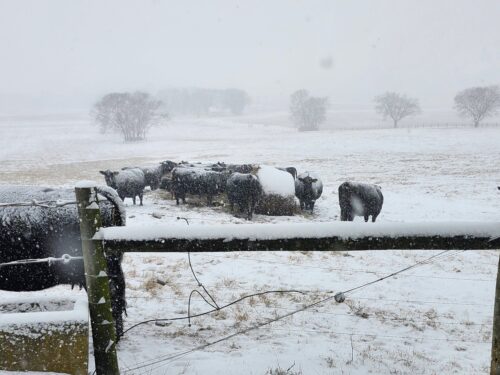

Dr. Katie Mason
Assistant Professor and Extension Beef Cattle Nutrition Specialist
Department of Animal Science
P: 865-974-8941
Originally published in Progressive Cattle magazine:
http://www.agproud.com/articles/60860-southeast-minding-the-gap
As we begin to wrap up the winter hay-feeding season and look towards spring, you may find that hay resources are beginning to dwindle. There are several things to keep in mind as you manage the gap between now and spring green-up.
First, assess current forage inventory. Determine the number of bales you have remaining and account for any stockpiled forage or other stored feed. It would be ideal to have forage analyses and bale weights to derive the most accurate estimates. Then, determine the daily forage requirements of your herd. This will depend on the stage of production, animal size, and weather conditions. Account for some waste to be on the conservative side with your estimate. By dividing the remaining forage inventory by daily requirements, you will have a better idea of whether you’ll make it through the rest of winter with the current forage on hand.
Next, assess the condition of the herd and adjust feeding rates as needed. If you have a spring calving herd, it is a critical time to improve body condition before calves start hitting the ground. During lactation, it can be challenging for cows to gain body condition, given their greater nutrient requirements. If possible, sort the herd into high priority and low priority nutrition groups. High priority animals, like pregnant and lactating cows, should receive higher quality hay and feed, where dry cows in good condition can get away with moderate quality.
If you find that hay supplies are short, explore options such as limit feeding, supplementation with commodity byproduct or commercial feeds, or alternative feeds. Limit-feeding can help to reduce feed waste and improve forage and feed use efficiency. Using hay analysis results to strategically supplement cattle will reduce the total amount of feed needed to get through the hay feeding season. Recognize that convenience feeds, such as protein tubs, can be a good source of protein but still there needs to be adequate dry matter and energy intake to make use of these feeds.
Finally, think ahead and plan for spring green up. If weather conditions are favorable, apply fertilizer according to soil test recommendations to give pastures a boost in the spring. This is also a good time to think about frost seeding clover, which will provide nitrogen and high-quality forage in the system. Manage stockpiled pastures appropriately, dividing out sections as needed and avoiding overgrazing. Begin to map out your grazing strategy for spring pastures. The spring flush of growth can often get ahead of us. To maximize use of the rapidly growing forage, rotate through pastures often.
A quick assessment and small adjustments to your nutritional strategy can ease you through the transition from winter to spring.